|
|
Created/dedicated as per personal communication with J. Merrill Lynch, July 4, 2011
Updated as per James P. Tuttle's The Hawk Moths of North America, September 12, 2011
Updated as per personal communication with Eric Smith, September 12, 2011
Updated as per BAMONA, (no Sphingidae species reported for Watauga), September 12, 2011
|
Watauga County, North Carolina
Sphingidae

Darapsa myron courtesy of Hynek Habal
This page is inspired by and dedicated to
J. Merrill Lynch who sent me sightings of
several Sphingidae from Watauga County, North Carolina.
Merrill writes, July 4, 2008, "Thanks for the id (Darapsa myron).
I have both Covell (Peterson field guide) and Tuttle's
Hawk Moths of North America. The dark green longitudinal
stripe on the forewing certainly fooled me, because the plates in
both books do not show this pattern for any Sphingidae although I
knew from the wing shape and other characters it had to be in that
family.
"The location is about 15 miles north of Boone in extreme northern
Watauga County, North Carolina. The coordinates are 36.37415 N,
81.71406 W, WGS 84. Elevation is 3,348 feet. Habitat: rich mixed
hardwood forest edge. Vitaceae species in the vicinity include
Vitis sp. and Parthenocissus quinquefolia.
"Other sphingids I have identified at this location include:
Eumorpha pandorus, Manduca jasminearum, Ceratomia undulosa,
Lintneria eremitus, Paonias excaecata, P. myops, Smerinthus
jamaicensis and Amorpha juglandis."
Thirty-six Sphingidae species are listed for North Carolina on the
U.S.G.S. website, now BAMONA. Not all of the species are reported or anticipated
in Watauga County.
(None are reported on U.S.G.S. as of July 4, 2008). It is
hoped that this checklist, with the thumbnails and notes, will help
you quickly identify the moths you are likely to encounter.
A "WO" after the species name indicates that
I have no confirmed reports of this species in Watauga County, but I
(William Oehlke) expect that this moth is present or
might be present.
Many thanks to Eric Smith who confirms Hyles lineata and Xylophanes tersa in Watauga County.
A "USGS"
indicates the moth is reported on the USGS website and/or in
Lepidoptera of North America, #1. Distribution of Silkmoths
(Saturniidae) and Hawkmoths (Sphingidae)
of Eastern North America,
an excellent little booklet available through Paul Opler.
Please help me develop this list with improved, documented accuracy
by sending sightings (species, date, location), preferably with an
electronic image, via email to
Bill Oehlke.
Please also send sightings to BAMONA, an excellent online resource.
Sphinginae subfamily
Sphingini tribe:
 |
This species is a strong migrant and adults nectar from
deep-throated flowers including moonflower (Calonyction aculeatum),
morning glory (Convolvulus), honey suckle (Lonicera)
and petunia (Petunia species).
|
 |
Ceratomia amyntor
WO,
the Elm Sphinx or Four-horned Sphinx
The upperside of the forewing is brown with dark brown and white
markings including a white costal area near the wing base, dark
streaks along the veins,
and a white spot in the cell.
Larvae feed on Elm (Ulmus), birch (Betula), basswood (Tilia), and
cherry (Prunus).
|
 |
The upperside of the forewing is yellowish brown with no white markings, but there are indistinct black lines and dashes. The cell spot is gray with a black outline. The larvae feed in large groups and are much more
spectacular than the moths.
Catalpa is the larval host.
|
 |
The upperside of the forewing is pale brownish gray with wavy black
and white lines and a black-outlined white cell spot. The upperside
of the hindwing is gray with diffuse darker bands.
|
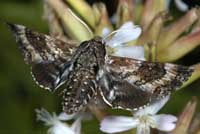 |
The upperside of the forewing is dark brown with a dusting of white
scales. Some moths have patches of reddish or yellowish brown on the
wings.
|
 |
The upperside of the forewing is gray with heavy black bands. The
upperside of the hindwing is brownish gray with no markings.
The underside is rather plain.
|
 |
The upperside is of the forewing is gray with two
(sometimes one or three) black dashes near the wing center; other
markings are usually diffuse. The upperside of the hindwing is a
uniform brown-gray.
If you've got pines, this species is likely present.
|
 |
Lintneria eremitus
JML, the
Hermit Sphinx:
The upperside of the forewing is gray-brown with wavy lines, black
dashes, and one or two small white spots near the center of the
costa. The upperside of the hindwing is black with two white bands
and a triangular black patch at the base. Note the golden hair on the
thorax.
|
 |
The upperside of forewing is gray to grayish brown with a black line
running from the middle of the costa to the middle of the outer
margin; the line may be broken near the margin. There is a splash of
brown around the cell spot.
|
 |
I suspect if you grow tomatoes, you are likely to encounter
Manduca quinquemaculata.
|
 |
Look for three large yellow spots
on each side of the abdomen. The upperside of the forewing is
yellowish brown to deep chocolate brown with a dusting of white
scales and zigzagged black and white lines. maybe
|
 |
If you grow tomatoes, you have probably encountered Manduca sexta
in the larval stage.
Larvae get very large and can strip a tomato plant.
|
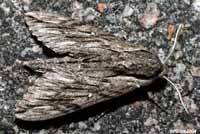 | The upperside of the forewing is gray with indistinct black and
white markings. There is a series of black dashes
from the base to the tip, and a small white cell spot.
|
 |
Sphinx chersis WO, the Northern Ash Sphinx or Great Ash Sphinx
Larval hosts are ash,
lilac, privet, cherry, and quaking aspen.
|
 |
We have them
on P.E.I., but I do not see them nearly as frequently
as I see the other Sphingidae.
|
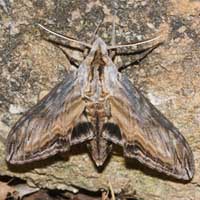 |
Sphinx franckii
WO, Franck's Sphinx Moth:
FW outer margins are slightly concave in male, not in female.
Costal half of forewings is grey, posterior portion is a distinctive
warm yellowish-brown; boundary between these two areas is marked with
series of dark diagonal streaks. HWs are
black with brown basal patch, median band and margin.
|
 | The upperside of the forewing ranges from brown with
black borders through brownish gray with paler borders to pale gray
with no borders. Dashes, submarginal line, and cell spot are usually
weak.
|
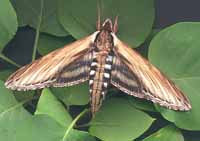 |
The lower forewings are predominantly brownish-yellow with a fairly
wide dark bar along the inner margin. At rest the wings hug the body,
giving the moth a long slender look.
|
Smerinthini Tribe:
 |
The adults are also highly variable; sometimes wings of an individual
may be all one color or may have several colors, ranging from pale to
dark brown, and may have a white or pink tinge. Patterns range from
faint to pronounced.
See the file for the female; she is different.
|
 |
Pachysphinx modesta
WO,
the Modest Sphinx or Poplar Sphinx
This moth has a large, heavy body, and females can be remarkably
plump.
Larvae are fond of poplars and willows.
|
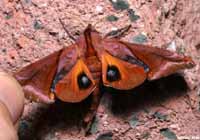 |
Paonias astylus flies from March-September in Florida and from
April-September in Louisiana. There is one brood northward from
June-August.
This appears to be an uncommon species.
|
 |
Named for the dull grey-blue spot (minus dark pupil) in the hindwing,
this moth has a wide distribution in the eastern United States.
I regularly see them on Prince Edward Island, and they are reported
as far south as Florida.
|
 |
Paonias myops
JML, the Small-eyed Sphinx
Named for the small eye-spot in the hindwing, this moth has a wide
distribution and is probably present in Buncombe County.
I regularly see them on Prince Edward Island, and they are reported
as far south as Florida.
|
 |
This moth is widely distributed and fairly common.
Along the East Coast, it flies from P.E.I. to Florida.
|
Macroglossinae subfamily
Dilophonotini tribe:
See Hemaris comparison to help distinguish
the next three species.
 |
Hemaris thysbe
WO, the Hummingbird Clearwing
It is not difficult to see why many gardeners would mistake an
Hemaris thysbe moth for a small hummingbird as it hovers,
sipping nectar from flowers through a long feeding tube.
|
 |
Hemaris diffinis
WO, the
Snowberry Clearwing or Bumblebee Moth
Adults mimic bumblebees and are quite variable. The wings are basically clear, with dark brown to
brownish-orange veins, bases and edges. The thorax is golden-brown to
dark greenish-brown. The abdomen tends to be dark (black) with 1-2
yellow segments before the tip.
|
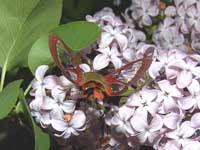 |
Hemaris gracilis WO, the
Slender Clearwing or Graceful Clearwing:
Hemaris gracilis is distinguished from similar species by a
pair of red-brown bands on the sides of the thorax, which varies from
green to yellow-green dorsally and sometimes brown with white
underneath.
They have a red abdomen. unlikely, generally more easterly
|
Philampelini tribe:
 |
Larvae get large and feed on grape vines and Virginia creeper.
Note the differences between this moth and the Pandorus Sphinx.
|
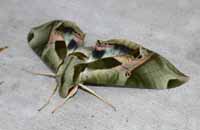 |
If you have Grape or Virginia Creeper nearby, then you probably have
this species.
I often get asked to identify larvae from areas not
previously reported. |
Macroglossini tribe:
 |
This day flier is widely distributed. If you have Virginia Creeper,
you probably have the Nessus Sphinx. Two bright, distinct, narrow
yellow bands are often visible on the abdomen.
|
 |
The lower wings of this hawkmoth are a solid brownish-orange,
matching the body colour.
You will often see this species listed as Darapsa pholus,
especially in older literature.
|
 |
Darapsa myron
JML, the Virginia Creeper Sphinx or the Grapevine Sphinx
If you have the
foodplants indicated in the common names, you probably have this
species nearby. The lower wings are orange.
|
Darapsa myron, June 25, 3500 feet, J. Merrill Lynch.
 |
If you have hydrangea growing near a stream, then you might have the
Hydrangea Sphinx.
|
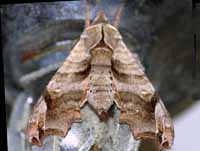 |
The moth's outer margin of the forewing is deeply scalloped.
The upperside is light brown with dark brown markings.
There is a small black and white spot near the tip.
Grape (Vitis), ampelopsis (Ampelopsis), and Virginia creeper
(Parthenocissus) all serve as larval hosts.
questionable
|
 |
Hyles lineata
ES, the White-lined Sphinx
The forewing upperside is dark olive brown with paler brown along the costa and outer margin, a narrow tan band running from the wing tip to the base, and white streaks along the veins.
The hindwing upperside is black with a reddish pink median band.
|
 |
Adults are said to mimic bumblebees and make a buzzing sound when
feeding. The wing margins are scalloped. The upperside of the
forewing is dark brown with light brown bands and markings. The
upperside of the hindwing is yellow with a wide black outer margin.
|
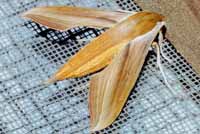 |
This moth is much more common to the south. It is a strong migrant,
however, and probably does establish itself in Watauga County, at least
periodically.
|
|
|
Enjoy some of nature's wonderments, giant silk moth cocoons.
These cocoons are for sale winter and fall. Beautiful Saturniidae moths will emerge the following spring and summer.
Read Actias luna rearing article.
Additional online help available.
Eggs of many North American species are offered during the spring and summer. Occasionally
summer Actias luna and summer Antheraea polyphemus cocoons are available. Shipping to US destinations is done
from with in the US.
Use your browser "Back" button to return to the previous page.
This page is brought to you by
Bill Oehlke and the
WLSS. Pages are on space rented from Bizland. If you would like
to become a "Patron of the Sphingidae Site", contact Bill.
Please send sightings/images to Bill. I will do my best to respond to
requests for identification help.
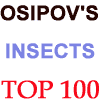 | 
Show appreciation for this site by clicking on flashing butterfly to the left.
The link will take you to a page with links to many insect sites. |
This website has been created and is maintained by Bill Oehlke without government or institutional financial assistance. All expenses, ie., text reference
support material, webspace rental from Bizland, computer repairs/replacements, backups systems, software for image adjustments (Adobe Photoshop; L-View),
ftp software, anti-virus protection, scanner, etc. are my own.
I very much appreciate all the many images that have been sent to me, or of which I have been granted permission to copy and post from other websites.
All images on this site remain the property of respective photographers.
If you would like to contribute to the maintenace of this website by sending a contribution to
Bill Oehlke
Box 476
155 Peardon Road
Montague, Prince Edward Island, C0A1R0
Canada
your donation would be much appreciated and would be used for
1) paying for webspace rental;
2) paying for computer maintenance and software upgrades;
3) purchases of additional text reference material (journals and books) in anticipation of expanding the site to a worldwide Sphingidae site;
4) helping to pay my daughter's tuition; with anything left over going to humanitarian aid.
If you are mailing a check from USA, please use $0.85 postage. Donations can also be made through Paypal via the button below.


